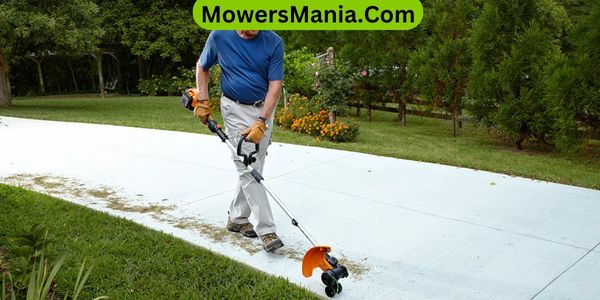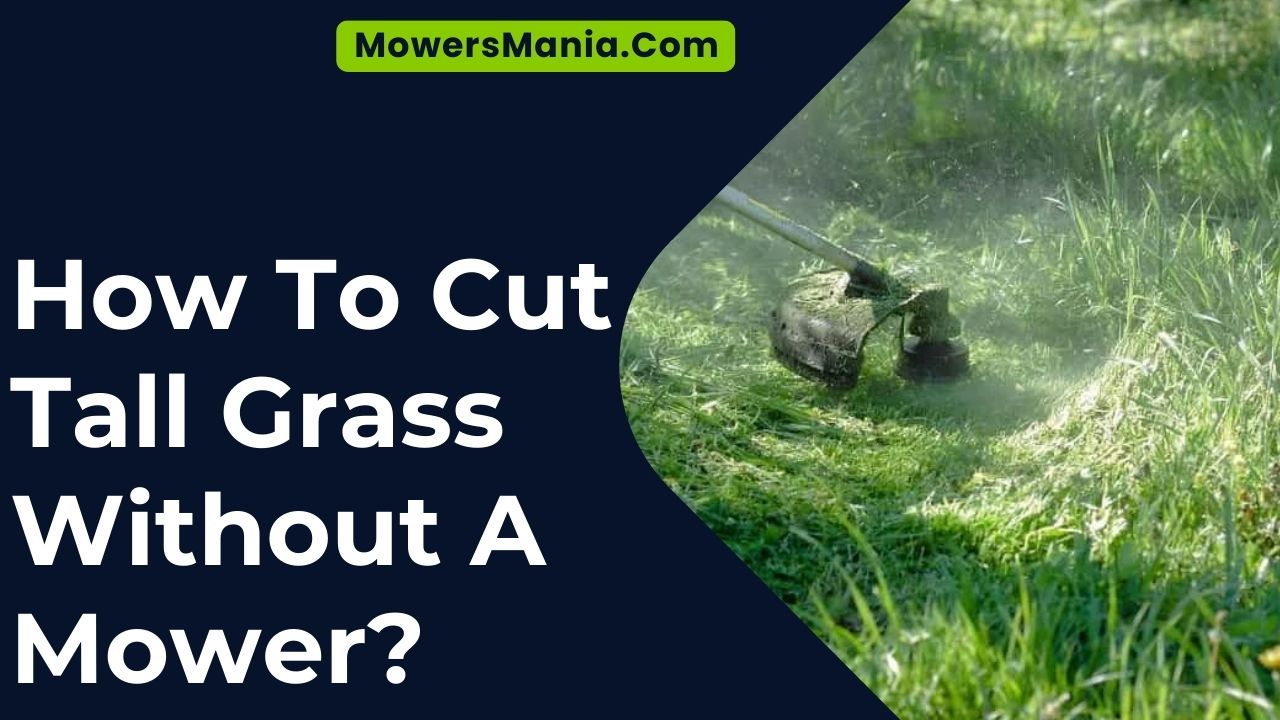If you’re facing overgrown grass and don’t have a mower, don’t worry – there are still ways to tackle the task. By choosing the right cutting tool, preparing the area, and employing the proper technique, you can effectively manage tall grass without a mower.
This article will guide you through the process, providing tips for using tools like a string trimmer, scythe, sickle, and hand shears, as well as aftercare and maintenance advice.

Choosing the Right Cutting Tool
When cutting tall grass without a mower, consider using a scythe for efficient and effective results. The scythe is a traditional tool that has been used for centuries to cut grass and grain.
Its long curved blade allows you to reach deep into the thick grass, making the cutting process easier.
When using a scythe, it’s crucial to maintain a proper cutting technique. Stand with your feet shoulder-width apart, and swing the scythe in a smooth, rhythmic motion, allowing the blade to slice through the grass cleanly.
Ensure that the blade is sharp for optimal performance, as a dull blade will make cutting more challenging and less effective.
Additionally, wearing protective gloves and long pants is advisable to prevent any accidental cuts or scrapes while using the scythe.
Preparing the Area for Cutting
Before preparing the area for cutting tall grass, ensure that the scythe is properly sharpened and your protective gear is in place.
Once you have checked these essentials, it’s time to clear the area of any large debris such as rocks, branches, or other obstacles that could interfere with the cutting process.
Walk the area and remove any visible obstructions to create a safe and efficient cutting environment.
Additionally, be mindful of any potential hazards such as holes or uneven ground that could pose a risk while using the scythe. It’s important to have a clear and unobstructed path to move through as you cut the tall grass.
After clearing the area, take a moment to assess the surrounding environment. Ensure there are no fragile objects or structures nearby that could be accidentally damaged during the cutting process.
If there are any delicate plants or objects, consider marking them or setting up barriers to protect them from the swinging motion of the scythe.
Using a String Trimmer or Weed Whacker

When using a string trimmer or weed whacker, it’s important to master effective trimming techniques and follow safety precautions.
You’ll also want to make sure you have the right gear and maintain your equipment for optimal performance.
Let’s explore these points to ensure you’re equipped to tackle tall grass without a mower.
Trimming Techniques and Tips
To cut tall grass without a mower, you can effectively trim it using a string trimmer or weed whacker.
When using a string trimmer, hold it at a slight angle and work in a sweeping motion to cut the grass evenly.
Start at the edge of the area and work your way inward, using a steady pace to ensure a consistent cut. Keep the trimmer head parallel to the ground to prevent scalping the grass.
For thicker patches, consider using a weed whacker with a blade attachment for more power.
Be sure to wear protective clothing, including gloves and eye goggles, and watch out for rocks or other debris that could be flung by the trimmer. Always follow the manufacturer’s safety guidelines to prevent accidents.
Safety Precautions and Gear
Are you prepared with the necessary safety gear and precautions to operate a string trimmer or weed whacker effectively? When using a string trimmer or weed whacker, it’s crucial to prioritize safety to avoid accidents and injuries.
Here’s what you need to keep in mind:
- Safety Gear:
- Wear protective eyewear to shield your eyes from flying debris.
- Use ear protection to minimize the noise level and protect your hearing.
- Precautions:
- Inspect the area for obstacles or hidden objects before starting.
- Maintain a firm grip on the tool and be mindful of your surroundings at all times.
Maintaining Your Equipment
Before using a string trimmer or weed whacker, ensure that you have properly maintained the equipment.
- Check the fuel levels and add fresh fuel if needed.
- Inspect the spark plug and replace it if it’s dirty or worn out.
- Clean the air filter and replace it if it’s clogged.
- Make sure the cutting head is free of any debris or tangled vegetation.
- Check the trimmer line for wear and replace it if it’s worn out or broken.
- Tighten any loose screws, nuts, or bolts.
- Lubricate any moving parts according to the manufacturer’s recommendations.
- Finally, inspect the safety guard and ensure it’s securely attached.
Employing a Scythe for Larger Areas
When cutting tall grass in larger areas, consider using a scythe for more efficient and precise results. A scythe can be a highly effective tool for tackling overgrown grass in expansive spaces.
Here’s why you should consider employing a scythe:
- Historical Significance: The scythe has a rich history and tradition, dating back centuries as a reliable tool for cutting grass and grains. Embracing this traditional method can add a unique and nostalgic element to your grass-cutting experience.
- Technique and Skill: Mastering the art of using a scythe can be a satisfying challenge, requiring a good sense of rhythm and precision. It offers a hands-on approach to grass cutting that can be both meditative and physically rewarding.
Utilizing a Sickle for Precision Cutting

When using a sickle for precision cutting, it’s important to ensure that the tool is sharp for efficient and clean cuts.
Technique plays a crucial role in utilizing a sickle effectively, so be sure to maintain a steady and controlled motion while cutting.
Sharp Sickle for Precision
To precisely cut tall grass without a mower, you’ll need a sharp sickle for accurate and efficient trimming. A sharp sickle ensures clean cuts and minimizes the effort required to tackle tall grass.
Here’s why a sharp sickle is essential:
- Precision Cutting: A sharp sickle allows you to precisely target and trim specific areas of the tall grass, giving your lawn a neat and well-maintained appearance.
- Ease of Use: With a sharp sickle, you can effortlessly navigate through dense patches of tall grass, ensuring that every blade is cut evenly and cleanly.
Technique for Efficient Cutting
Sharpen the sickle blade to ensure precise and efficient cutting of tall grass. Hold the sickle at a slight angle and swing it in an arc motion, directing the blade towards the base of the grass.
Use your non-dominant hand to gather a small bunch of grass and hold it firmly, allowing the sickle to cut through it cleanly.
Work in small sections, taking care not to overexert yourself. Keep a steady rhythm and maintain a consistent cutting angle to achieve a uniform result. Clear away cut grass regularly to prevent it from impeding your progress.
For taller grass, consider cutting in layers, starting from the outer edges and working your way towards the center to manage the volume effectively.
Hand Shears for Detail Work
You’ll need a sharp pair of hand shears to tackle the detailed work of cutting tall grass without a mower. Hand shears are essential for precise cutting, especially around delicate plants and tight spaces.
Here’s why they’re crucial for your tall grass cutting needs:
- Precision Cutting: Hand shears allow you to trim grass with precision, ensuring a neat and tidy look for your lawn or garden. They’re especially useful for shaping edges and creating defined borders around flower beds and walkways.
- Tip: When using hand shears for detailed work, make sure to keep the blades sharp for clean cuts, and consider wearing gloves to protect your hands from blisters and calluses.
- Versatility: These shears are versatile tools that can handle various cutting tasks beyond just tall grass. You can use them for pruning shrubs, trimming hedges, and even harvesting herbs and flowers.
- Tip: For optimal results, choose hand shears with a comfortable grip and adjustable blades to accommodate different cutting needs.
With the right pair of hand shears, you can achieve a well-groomed landscape even without a mower.
Aftercare and Maintenance

After using the hand shears for cutting tall grass without a mower, it’s important to focus on the aftercare and maintenance to keep them in optimal condition for future use.
Proper maintenance not only ensures the longevity of your hand shears but also guarantees efficient performance.
Here’s a simple guide to help you maintain your hand shears:
| Aftercare | Maintenance |
|---|---|
| Clean | After use, wipe the blades with a damp cloth and dry thoroughly to prevent rust. |
| Lubricate | Apply a thin layer of oil to the blades and pivot points to prevent corrosion and ensure smooth movement. |
| Sharpen | Regularly sharpen the blades with a sharpening stone to maintain cutting efficiency. |
| Store Properly | Store the hand shears in a dry place, preferably hanging to prevent damage to the blades and maintain their edge. |
Following these aftercare and maintenance practices will keep your hand shears in top condition and ready for the next time you need to tackle tall grass without a mower.
Frequently Asked Questions [FAQs]
Can I Use a Lawnmower on Tall Grass Instead of the Recommended Cutting Tools?
You can use a lawnmower on tall grass, but it’s not the recommended cutting tool. It may struggle with tall grass and potentially get clogged. Consider using a scythe or a string trimmer for better results.
Are There Any Environmentally Friendly Options for Cutting Tall Grass Without a Mower?
You can cut tall grass without a mower by using a scythe or a manual grass cutter. Both options are environmentally friendly and provide a good workout. Make sure to wear protective gear.
What Are Some Common Mistakes to Avoid When Cutting Tall Grass Without a Mower?
When cutting tall grass without a mower, be mindful of uneven terrain and hidden objects. Ensure your cutting tool is sharp and avoid cutting in wet conditions. Clear the area of debris before starting.
How Can I Prevent Tall Grass From Growing Back Quickly After Cutting?
To prevent tall grass from growing back quickly after cutting, regularly mow or trim it and remove any clippings. This helps to weaken the grass and reduces the chance of it growing back rapidly.
What Are Some Safety Precautions to Keep in Mind When Using Cutting Tools for Tall Grass?
When cutting tall grass, be sure to wear protective gear like gloves and safety goggles. Clear the area of any debris or obstacles before getting started. Always follow proper handling and storage procedures for cutting tools.
Conclusion
Now that you know how to cut tall grass without a mower, you can take on overgrown areas with confidence. Whether you choose a string trimmer, scythe, sickle, or hand shears, proper preparation and aftercare are essential for a job well done.
By following these steps, you can maintain your property and keep it looking neat and tidy without the need for a traditional lawn mower.



